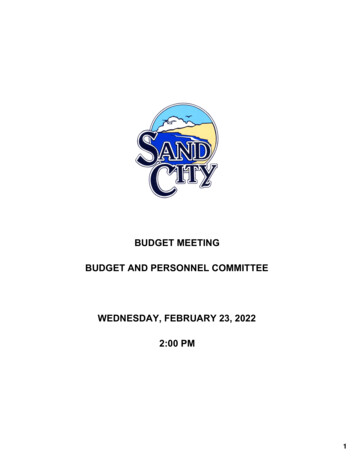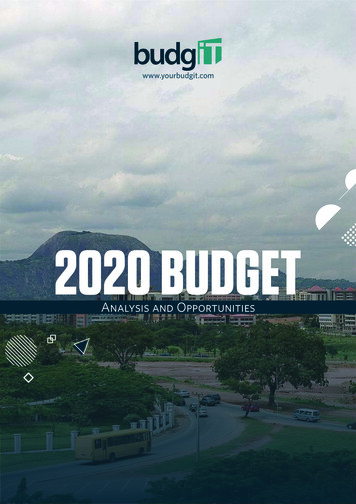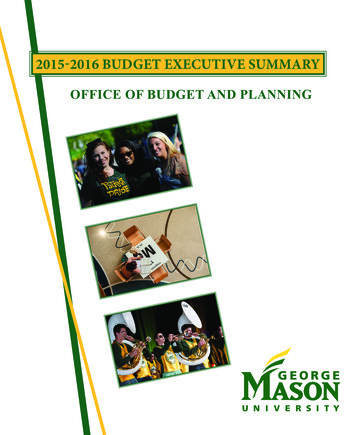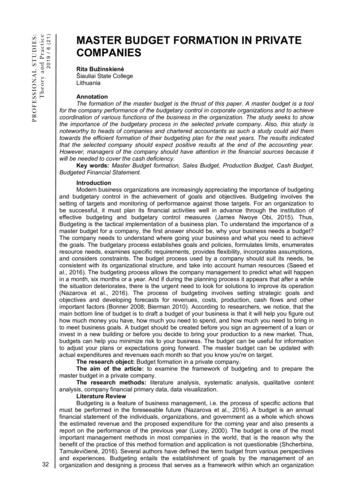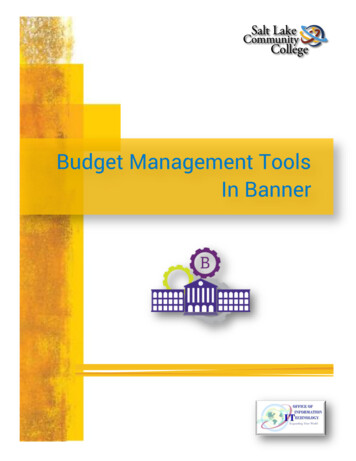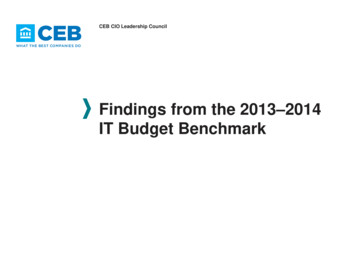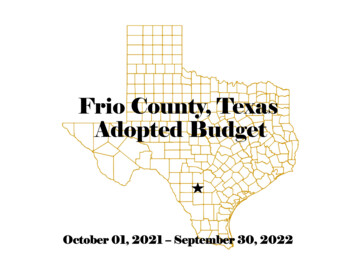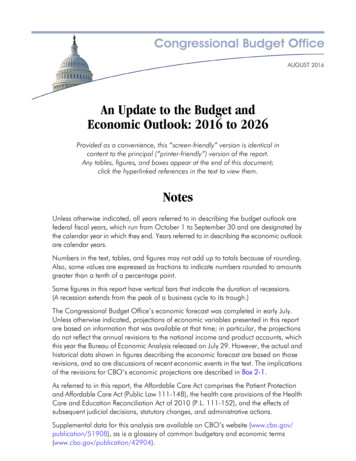
Transcription
AUGUST 2016An Update to the Budget andEconomic Outlook: 2016 to 2026Provided as a convenience, this “screen-friendly” version is identical incontent to the principal (“printer-friendly”) version of the report.Any tables, figures, and boxes appear at the end of this document;click the hyperlinked references in the text to view them.NotesUnless otherwise indicated, all years referred to in describing the budget outlook arefederal fiscal years, which run from October 1 to September 30 and are designated bythe calendar year in which they end. Years referred to in describing the economic outlookare calendar years.Numbers in the text, tables, and figures may not add up to totals because of rounding.Also, some values are expressed as fractions to indicate numbers rounded to amountsgreater than a tenth of a percentage point.Some figures in this report have vertical bars that indicate the duration of recessions.(A recession extends from the peak of a business cycle to its trough.)The Congressional Budget Office’s economic forecast was completed in early July.Unless otherwise indicated, projections of economic variables presented in this reportare based on information that was available at that time; in particular, the projectionsdo not reflect the annual revisions to the national income and product accounts, whichthis year the Bureau of Economic Analysis released on July 29. However, the actual andhistorical data shown in figures describing the economic forecast are based on thoserevisions, and so are discussions of recent economic events in the text. The implicationsof the revisions for CBO’s economic projections are described in Box 2-1.As referred to in this report, the Affordable Care Act comprises the Patient Protectionand Affordable Care Act (Public Law 111-148), the health care provisions of the HealthCare and Education Reconciliation Act of 2010 (P.L. 111-152), and the effects ofsubsequent judicial decisions, statutory changes, and administrative actions.Supplemental data for this analysis are available on CBO’s website (www.cbo.gov/publication/51908), as is a glossary of common budgetary and economic terms(www.cbo.gov/publication/42904).
AN UPDATE TO THE BUDGET AND ECONOMIC OUTLOOK: 2016 TO 2026AUGUST 2016SummaryIn fiscal year 2016, the federal budget deficit will increase in relation to economicoutput for the first time since 2009, the Congressional Budget Office estimates.If current laws generally remained unchanged—an assumption underlying CBO’sbaseline projections—deficits would continue to mount over the next 10 years, anddebt held by the public would rise from its already high level.CBO’s estimate of the deficit for 2016 has increased since the agency issued itsprevious estimates in March, primarily because revenues are now expected to be lowerthan earlier anticipated.1 In contrast, the cumulative deficit through 2026 is smaller inCBO’s current baseline projections than the shortfall projected in March, chieflybecause the agency now projects lower interest rates and thus lower outlays for interestpayments on federal debt. Nevertheless, by 2026, the deficit is projected to beconsiderably larger relative to gross domestic product (GDP) than its average over thepast 50 years.CBO’s economic forecast—which serves as the basis for its budget projections—indicates that, after a tepid expansion in the first half of 2016, economic growth willpick up in the second half of the year. That faster pace is expected to continue through2017 before moderating in 2018. In CBO’s estimation, the faster growth over the nexttwo years will spur hiring, increase employment and wages, and put upward pressureon inflation and interest rates. In the latter part of the 10-year projection period,however, output will be constrained by a relatively slow increase in the nation’s supplyof labor.The growth in GDP that CBO now projects is slower throughout the 2016–2026 periodthan the agency projected in January.2 Weaker-than-expected economic growthindicated by data released since January, recent developments in the global economy,and a reexamination of projected productivity growth contributed to that downwardrevision. The reduction to CBO’s projections of interest rates reflects the revisions toprojected economic growth as well as CBO’s reassessment of the future demand forTreasury securities.The Budget Deficit for 2016 Will Be About One-Third Larger ThanLast Year’sCBO now estimates that the 2016 deficit will total 590 billion, or 3.2 percent of GDP,exceeding last year’s deficit by 152 billion (see Summary Table 1). About 41 billion1. For CBO’s March 2016 projections, see Congressional Budget Office, Updated Budget Projections:2016 to 2026 (March 2016), www.cbo.gov/publication/51384.2. CBO’s previous economic projections were reported in January 2016; see Congressional BudgetOffice, The Budget and Economic Outlook: 2016 to 2026 (January 2016), www.cbo.gov/publication/51129.CBO2
AN UPDATE TO THE BUDGET AND ECONOMIC OUTLOOK: 2016 TO 2026AUGUST 2016of that increase results from a shift in the timing of some payments that the governmentwould ordinarily have made in fiscal year 2017; those payments will instead be madein fiscal year 2016 because October 1, 2016 (the first day of fiscal year 2017), falls ona weekend.3 If not for that shift, the projected deficit in 2016 would be 549 billion, or3.0 percent of GDP—still considerably higher than the deficit recorded for 2015, whichwas 2.5 percent of GDP.The deficit is growing in 2016 because revenues are up only slightly, by lessthan 1 percent ( 26 billion), whereas outlays are projected to rise by 5 percent( 178 billion). As a share of GDP, total revenues are expected to fall from 18.2 percentto 17.8 percent. In contrast, outlays are projected to rise to 21.1 percent of GDP, upfrom 20.7 percent last year. That increase is the result of the following: a 6 percent rise,in nominal terms, in mandatory spending for programs such as Social Security andMedicare (which is generally governed by statutory criteria); a 1 percent increase indiscretionary outlays (which stem from annual appropriations); and an 11 percent jumpin net interest outlays.4 Debt held by the public will amount to nearly 77 percent ofGDP by the end of 2016, CBO estimates—3 percentage points higher than last yearand its highest ratio since 1950.Growing Deficits Projected Through 2026 Would Drive Up DebtIn CBO’s baseline projections, the budget deficit is generally on an upward trend overthe next decade, reaching 4.6 percent of GDP in 2026. A slight decline in the deficitover the next two years is largely explained by the shift in the timing of payments fromone fiscal year to another because certain scheduled payments fall on weekends. Inlater years, continued growth in spending—particularly for Social Security, Medicare,and net interest—would outstrip growth in revenues, resulting in larger deficits andincreasing debt.OutlaysIn CBO’s projections, annual federal outlays rise by 2.4 trillion (or about 60 percent)from 2016 to 2026. Relative to the size of the economy, outlays remain near21 percent of GDP for the next few years—higher than their average of 20.2 percentover the past 50 years. Later in the coming decade, the growth in outlays would exceedgrowth in the economy, and by 2026, outlays would rise to 23.1 percent of GDP. That3. October 1 will fall on a weekend not only in calendar year 2016 but also in calendar years 2017,2022, and 2023. In all of those years, certain payments due on October 1 will instead be made atthe end of September and thus be shifted into the previous fiscal year. The shifts noticeably boostprojected spending and deficits in fiscal years 2016 and 2022 and reduce them in fiscal years 2018and 2024.4. About 37 billion of the increase in mandatory spending and 4 billion of the increase indiscretionary spending result from the timing shift mentioned above. If not for that shift, total outlayswould rise by 4 percent this year (and equal 20.8 percent of GDP); mandatory spending would riseby 4 percent, and discretionary spending by 1 percent.CBO3
AN UPDATE TO THE BUDGET AND ECONOMIC OUTLOOK: 2016 TO 2026AUGUST 2016increase reflects significant growth in mandatory spending and interest payments, offsetsomewhat by a decline, in relation to the size of the economy, in discretionaryspending. More specifically: Outlays for mandatory programs are projected to rise by close to 70 percent innominal terms from 2016 to 2026, increasing as a percentage of GDP by almost2 percentage points over that period. That increase is mainly attributable to theaging of the population and rising health care costs per person, which substantiallyboost projected spending for Social Security and Medicare. Because of rising interest rates and, to a lesser extent, growing federal debt, thegovernment’s interest payments on that debt are projected to rise sharply over thenext 10 years—nearly tripling in nominal terms and almost doubling relative to GDP. In contrast, discretionary spending is projected to rise by a much smaller amount innominal terms, consequently dropping to a smaller percentage of GDP than in anyyear since 1962 (the first year for which comparable data are available).RevenuesIf current laws generally remained unchanged, revenues would gradually rise—by 1.7 trillion, or about 50 percent, from 2016 to 2026—increasing from 17.8 percentof GDP in 2016 to 18.5 percent by 2026. They have averaged 17.4 percent of GDPover the past 50 years.Only revenues from individual income taxes would grow faster than the economy. InCBO’s baseline, with revenues from each source measured as a percentage of GDP: Receipts from individual income taxes increase each year—for a total rise of1.3 percentage points over the 10-year period—because of real bracket creep (theprocess in which, as income rises faster than prices, an ever-larger proportion ofincome becomes subject to higher tax rates), rising distributions from tax-deferredretirement accounts, an increase in the share of wages and salaries earned byhigher-income taxpayers, and other factors. Remittances from the Federal Reserve, which have been unusually high since 2010,return to more typical levels, dropping by 0.4 percentage points from 2016 to 2026. Payroll tax receipts decline by 0.2 percentage points over the next decade, primarilybecause of the expected increase in the share of wages going to higher-incometaxpayers. Corporate income tax receipts change little over the 10-year period.CBO4
AN UPDATE TO THE BUDGET AND ECONOMIC OUTLOOK: 2016 TO 2026AUGUST 2016Debt Held by the PublicAs deficits accumulate in CBO’s baseline, debt held by the public rises from 77 percentof GDP ( 14 trillion) at the end of 2016 to 86 percent of GDP ( 23 trillion) by 2026. Atthat level, debt held by the public, measured as a percentage of GDP, would be morethan twice the average over the past five decades (see Summary Figure 1). Beyond the10-year period, if current laws remained in place, the pressures that contributed torising deficits during the baseline period would accelerate and push up debt evenmore sharply. Three decades from now, for instance, debt held by the public isprojected to be about twice as high, relative to GDP, as it is this year—which would behigher than the United States has ever recorded.5Such high and rising debt would have serious negative consequences for the budgetand the nation: Federal spending on interest payments would increase substantially as a result ofincreases in interest rates, such as those projected to occur over the next few years. Because federal borrowing reduces total saving in the economy, the nation’s capitalstock would ultimately be smaller, and productivity and total wages would be lower. Lawmakers would have less flexibility to use tax and spending policies to respond tounexpected challenges. The likelihood of a fiscal crisis in the United States would increase. There would be agreater risk that investors would become unwilling to finance the government’sborrowing needs unless they were compensated with very high interest rates; if thathappened, interest rates on federal debt would rise suddenly and sharply.The Projected Deficit for 2016 Is Larger Than CBO’s March Estimate,but the 10-Year Deficit Is Below Previous ProjectionsThe deficit that CBO now projects for 2016 is 56 billion larger than the amount theagency estimated in March. Revenues and outlays are both expected to be lower:revenues by 87 billion, mostly as a result of lower collections of individual andcorporate income taxes, and outlays by 31 billion.For the 2017–2026 period, CBO now projects a cumulative deficit that is 0.7 trillionsmaller than the 9.3 trillion the agency previously projected. The average deficit in thebaseline over the 2017–2026 period is 3.8 percent of GDP, compared with the4.0 percent CBO projected in March.5. See Congressional Budget Office, The 2016 Long-Term Budget Outlook (July 2016), www.cbo.gov/publication/51580. The projection of debt held by the public that CBO published in that report wasbased on the agency’s March 2016 baseline projections.CBO5
AN UPDATE TO THE BUDGET AND ECONOMIC OUTLOOK: 2016 TO 2026AUGUST 2016That decrease stems primarily from revisions to CBO’s economic forecast. Projectedrevenues over the 10-year period are 0.4 trillion (1 percent) lower, in large partbecause of lower projected nominal GDP. However, projected outlays are lower bymuch more— 1.1 trillion (2 percent)—mainly because CBO anticipates lower interestrates, and thus smaller interest payments, than it did in March.By 2026, debt held by the public is projected to total 23 trillion, whereas in March itwas projected to total 24 trillion. Because CBO also lowered its projection of GDP forthat year, both of those amounts equal 86 percent of GDP.Economic Growth and Interest Rates Are Projected to Increase in theNear Term but Remain Lower Than in Earlier DecadesAccording to CBO’s projections, the economic expansion over the next two years willreduce the quantity of underused resources, or “slack,” in the economy. In addition,interest rates on federal borrowing are expected to rise over the next few years. Beyondthe next two years, the economy is expected to grow more slowly.Economic GrowthIn real terms (that is, with adjustments to exclude the effects of inflation), GDP rose atan annual rate of 1.0 percent in the first half of calendar year 2016. However, CBOexpects that the economy will expand more rapidly in the coming months, with GDPgrowing by 2.0 percent over the whole of 2016 and by 2.4 percent in 2017—mainlybecause the major forces restraining the growth of investment, such as a decline in oilprices, have begun to subside (see Summary Figure 2). Economic growth is expected toslow in 2018 and fall below but remain close to the growth of potential (maximumsustainable) GDP in 2019 and 2020. Most of the growth in output during the comingyears will be driven by consumers, businesses, and home builders, CBO anticipates.CBO’s projections for the second half of the 10-year period are not based on forecastsof cyclical developments in the economy; rather, they are based on the projected trendsof underlying factors, such as growth in the labor force, the number of hours worked,and productivity. According to those projections, productivity will grow faster than it didover the past decade, and both actual and potential GDP will expand at an averageannual rate of about 2 percent. However, that rate represents a significant slowdownfrom the average growth in potential output that occurred during the 1980s, 1990s,and early 2000s—mainly because of slower projected growth in the nation’s supply oflabor, which is largely attributable to the ongoing retirement of baby boomers and therelatively stable labor force participation rate among working-age women.Interest RatesBecause of slow economic growth in the first half of the year and increased uncertaintyabout global economic growth and financial stability, CBO expects the Federal Reserveto hold the target range for the federal funds rate at 0.25 percent to 0.5 percent untilCBO6
AN UPDATE TO THE BUDGET AND ECONOMIC OUTLOOK: 2016 TO 2026AUGUST 2016the fourth quarter of 2016. (The federal funds rate is the interest rate that financialinstitutions charge one another for overnight loans of their monetary reserves.) CBOanticipates that the central bank will gradually reduce the extent to which monetarypolicy supports economic growth, and, as a result, the federal funds rate will rise to1.8 percent in the fourth quarter of 2018 and average 3.1 percent during the 2021–2026 period.Interest rates on federal borrowing will also increase gradually over the next few years,CBO projects, as slack in the economy continues to diminish, inflation returns to theFederal Reserve’s 2 percent target, and the federal funds rate rises. For example, CBOprojects that the interest rate on 10-year Treasury notes will be 1.9 percent in the fourthquarter of 2016, rise to 3.4 percent in the fourth quarter of 2020, and average3.6 percent over the 2021–2026 period. That projected rise in interest rates reflectsthe expectation that both foreign and domestic economic growth will improve, whichshould result in higher interest rates abroad as well as in the United States. In addition,CBO expects the “term premium”—the extra return paid to bondholders for riskassociated with holding long-term Treasury securities—to increase from historically lowlevels. In CBO’s estimation, the term premium has remained low, in part, because oflow foreign interest rates, heightened concern about global economic growth, andincreased demand for Treasury securities as a hedge against possible adverseeconomic outcomes.Although CBO projects that interest rates will rise above those currently in effect, theywould still be lower than the average rates during the 25-year period that preceded themost recent recession for several reasons: slower growth in the labor force, slightlyslower growth in productivity, and only partial dissipation of the factors that have helddown the term premium and increased the demand for Treasury securities.The Labor MarketAccording to CBO’s estimates, the growth in output will heighten demand for laborover the next year and a half, leading to solid employment gains and eliminating labormarket slack in 2017, thereby putting upward pressure on wages. The agency projectsthat the unemployment rate will fall below the estimated natural rate of unemployment(the rate that arises from all sources except fluctuations in the overall demand forgoods and services), bottoming out at 4.5 percent in the fourth quarter of 2017. InCBO’s projections for later years, which are primarily based on long-term trends, theunemployment rate rises to 4.9 percent.The increases in employment and wages in the near term are expected to mitigate anotherwise prevailing decline in participation in the labor force—both by encouragingpeople who were out of the labor force because of weak job prospects to enter it andby encouraging people who were considering leaving the labor force to remain in it. Asa result, CBO anticipates that over the next year and a half, the rate of labor forceparticipation will change little from the 62.7 percent that it was in the second quarter ofCBO7
AN UPDATE TO THE BUDGET AND ECONOMIC OUTLOOK: 2016 TO 2026AUGUST 2016this year. (The labor force participation rate is the percentage of people in the civiliannoninstitutionalized population who are at least 16 years old and are either working orseeking work.) It is projected to decline by roughly 2½ percentage points through2026.The prevailing decline in the labor force participation rate reflects underlyingdemographic trends and, to a smaller degree, federal policies. More specifically,the factors that contribute to that decline include the continued retirement of babyboomers, reduced participation by less-skilled workers, and the lingering effects of therecession and weak recovery. In addition, certain aspects of federal laws, includingprovisions of the Affordable Care Act and the structure of the tax code, will reduceparticipation in the labor force by reducing people’s incentive to work or seek work.InflationCBO expects that the diminishing slack in the economy, along with higher prices forcrude oil, will put upward pressure on prices for goods and services. That upwardpressure will be somewhat alleviated by the effects of a strong dollar in relation to othercurrencies. This year, CBO projects, the rate of inflation in the price index for personalconsumption expenditures will rise to 1.5 percent from 0.5 percent in 2015. In 2017,the rate of inflation is projected to rise to the Federal Reserve’s longer-run goal of2.0 percent; in CBO’s projections, it remains at that rate throughout the comingdecade.GDP and Interest Rates Are Now Projected to Be Lower ThanCBO Estimated in JanuaryCBO’s current economic projections differ in two important respects from those theagency made in January 2016. First, potential and actual real GDP are lower: By2026, those measures are 1.6 percent lower than CBO previously projected. Second,interest rates are significantly lower than CBO projected in January. By 2026, shortterm rates are 0.4 percentage points lower, and long-term rates are 0.5 percentagepoints lower. Other changes to CBO’s projections are more modest.CBO now projects slower growth in real GDP for 2016, largely because growth duringthe first half of the year was weaker than previously anticipated. Downward revisionsto potential and actual GDP over the decade were made on the basis of new dataand a reassessment of projected growth in the labor force and in potential total factorproductivity in the nonfarm business sector. (Total factor productivity is the average realoutput per unit of combined labor and capital services.)The weak growth so far this year, coupled with uncertainty about the effects of theUnited Kingdom’s vote to leave the European Union, leads CBO to anticipate that theFederal Reserve will raise the federal funds rate more slowly than was projected inJanuary. As a result of that revision, and because of lower projected interest ratesCBO8
AN UPDATE TO THE BUDGET AND ECONOMIC OUTLOOK: 2016 TO 2026AUGUST 2016abroad, CBO has revised downward its projections for the interest rates on 3-monthTreasury bills and 10-year Treasury notes over the next several years. The downwardrevision to interest rates over the rest of the decade primarily reflects greater expecteddemand for Treasury securities.Chapter 1: The Budget OutlookThe Congressional Budget Office estimates that the federal budget deficit in fiscal year2016 will total 590 billion, or 3.2 percent of gross domestic product (GDP), up from2.5 percent in 2015. This year’s deficit will mark the first increase in the budgetshortfall, measured as a share of the nation’s output, since 2009 (see Figure 1-1). As aresult, debt held by the public is expected to increase to almost 77 percent of GDP at theend of 2016—about 3 percentage points higher than last year’s amount and thehighest ratio since 1950.The deficit projected for this year is 56 billion above the estimate that CBO publishedin March, primarily because receipts from individual and corporate income taxes havebeen lower than anticipated.6 The agency also has reduced its baseline projection of thecumulative deficit for the 2017–2026 period by 712 billion—from 9.3 trillion to 8.6 trillion. The projected deficit for 2017 is larger, but those projected for every yearbetween 2018 and 2026 are smaller.Revenues in CBO’s baseline over the 10-year period are 431 billion (or 1 percent)below the amount that CBO previously reported, in large part because of lowerprojected nominal GDP. However, projected outlays decline by a larger amount— 1.1 trillion (or 2 percent)—mainly because CBO anticipates lower interest rates andthus smaller interest payments than it did in March. Despite the reduction in projecteddeficits, debt held by the public at the end of 2026 remains at about the samepercentage of GDP, largely because CBO has reduced its estimate of economic outputin that year.As specified in law, CBO constructs its baseline projections of federal revenues andspending under the assumption that current laws will generally remain unchanged.Under that assumption, annual budget shortfalls in CBO’s baseline rise substantiallyover the 2017–2026 period—from a low of 520 billion in 2018 to 1.2 trillion in2026.7 That increase is projected to occur mainly because growth in revenues wouldbe outpaced by a combination of significant growth in spending on health care and6. See Congressional Budget Office, Updated Budget Projections: 2016 to 2026 (March 2016),www.cbo.gov/publication/51384.7. CBO’s updated baseline projections incorporate the effects of legislation and administrative actionsthrough July 15, 2016.CBO9
AN UPDATE TO THE BUDGET AND ECONOMIC OUTLOOK: 2016 TO 2026AUGUST 2016retirement programs—caused by the aging of the population and rising health carecosts per person—and growing interest payments on federal debt.Deficits are projected to dip from 3.1 percent of GDP in 2017 to 2.6 percent in2018 and then to begin rising again, reaching 4.6 percent at the end of the 10-yearperiod—significantly above the average deficit as a percentage of GDP between 1966and 2015. Over the next 10 years, revenues and outlays alike are projected to beabove their 50-year averages as measured relative to GDP (see Figure 1-2).In CBO’s current baseline projections, federal debt held by the public as a percentageof GDP grows in nearly every year, reaching 86 percent by 2026. By comparison,federal debt has averaged 39 percent of GDP over the past five decades. Beyond2026, if current laws remained in place, the pressures that contribute to rising deficitsduring the coming decade would accelerate and push debt up sharply relative to GDP.8Such high and rising debt would have serious consequences, both for the economy andfor the federal budget. Federal spending on interest payments would increasesubstantially as a result of increases in interest rates, such as those projected to occurover the next few years. Moreover, because federal borrowing reduces national savingover time, the nation’s capital stock ultimately would be smaller, and productivity andincome would be lower than would be the case if the debt was smaller. In addition,lawmakers would have less flexibility than otherwise to respond to unexpectedchallenges, such as significant economic downturns or financial crises. Finally, thelikelihood of a fiscal crisis in the United States would increase. Specifically, the riskwould rise of investors’ becoming unwilling to finance the government’s borrowingunless they were compensated with very high interest rates. If that occurred, interestrates on federal debt would rise suddenly and sharply relative to rates of return on otherassets.The Budget Outlook for 2016In the absence of additional legislation that would affect spending or revenues, thedeficit in fiscal year 2016 will be 590 billion, 152 billion more than the shortfallrecorded in 2015, CBO estimates (see Table 1-1). Part of that increase is attributableto a shift of certain payments from fiscal year 2017 into fiscal year 2016 (becauseOctober 1, 2016, falls on a weekend). Without that shift, CBO estimates, the deficitwould amount to 549 billion in 2016. (For more details about timing shifts in thebaseline, see Box 1-1.)Even after adjusting for the shift in payments, CBO anticipates an increase in the budgetshortfall for 2016. Revenues, which rose by almost 8 percent last year, are expected toincrease by about 1 percent in 2016—significantly less than the increase in outlays,8. For a more detailed discussion, see Congressional Budget Office, The 2016 Long-Term BudgetOutlook (July 2016), www.cbo.gov/publication/51580.CBO10
AN UPDATE TO THE BUDGET AND ECONOMIC OUTLOOK: 2016 TO 2026AUGUST 2016which are anticipated to grow by nearly 4 percent this year (after adjusting for the timingshifts). As a percentage of GDP, the deficit will increase in 2016 to 3.2 percent, CBOestimates, exceeding last year’s deficit of 2.5 percent as well as the 2.8 percentaverage recorded over the past 50 years; if not for the timing shifts, the deficit would be3.0 percent of GDP.Outlays in 2016Outlays are expected to increase by 178 billion this year to a total of 3.9 trillion.CBO projects that federal spending will equal 21.1 percent of GDP, which is aboveboth last year’s 20.7 percent and the 20.2 percent average over the past 50 years. Ifnot for the shift of some payments, outlays in 2016 would increase by 137 billion andwould equal 20.8 percent of GDP, CBO estimates, slightly above last year’spercentage.Growth in outlays for 2016 is driven by an increase in mandatory spending (above therate of growth of the economy) and higher interest payments; discretionary outlays areprojected to rise only slightly from last year’s total. Specifically, adjusted for the shift intiming: Mandatory spending is estimated to rise by about 4 percent in nominal terms in2016, increasing to 13.1 percent of GDP (compared with 12.9 percent in 2015).9 Discretionary spending is projected to increase by 1 percent this year but fall to6.4 percent of GDP (compared with 6.6 percent last year).10 Net interest spending is expected to rise by about 11 percent, increasing to1.4 percent of GDP (compared with 1.3 percent in 2015).Mandatory Spending. Outlays for mandatory programs will rise to 2.4 trillion this year,CBO estimates, an increase of 139 billion from 2015 (see Table 1-2). Without the shiftin the timing of some payments, mandatory spending would grow by 102 billion.Most mandatory spending is for the federal government’s major health care programsand Social Security. Those health care programs consist of Medicare, Medica
AN UPDATE TO THE BUDGET AND ECONOMIC OUTLOOK: 2016 TO 2026 AUGUST 2016 3 of that increase results from a shift in the ti ming of some payments that the government would ordinarily have made in fiscal year 2017; those payments will instead be made in fiscal year 2016 because Oc tober 1, 2016 (the first day of fiscal year 2017), falls on




